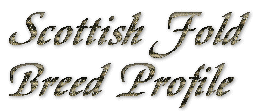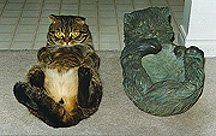 |
 |
||||||||||||||
|
By Linnea Danielsen and DeLynne Satimore Appearance As explained elsewhere in this web site, not all Scottish Folds have folded ears. Nonetheless, the breed has developed its own unique look. Their gentle, open owl appearance, even of the straight eared Folds, quickly made them popular. They are now considered one of the ten most popular cats in the United States. The breed is best known for its distinctive ears, which are small and tightly folded forward and down on its rounded head. The tips should be rounded. Straight eared cats have medium-sized ears. Eyes should be large, round and broadly spaced, thus giving the breed a sweet, wide-eyed expression. The Scottish Fold is a medium sized cat that is stocky and rounded. Males range from 9 to 13 pounds, females 6 to 9 pounds. A Fold should have a well rounded, padded look to the entire body. The head should appear round from all angles except for the moderate muzzle which is attached to the rounded head. While the head should be domed, it should not have a high arch but a gentle rounding that gently transitions into a very short neck. Whisker pads should be well-rounded with whiskers which often curve forward. The jaw should be firm and well rounded. The nose is gently curved with no break, short and wide due to the wide set of the eyes. Sometimes the curve of the mouth around their prominent whisker pads gives the appearance of a "smiling" cat. As you can see from the description, the Scottish Fold's head should look round in all ways with a moderate muzzle. The Scottish Fold can be found in both the shorthair and longhaired version. The longhaired Scottish Fold has a semi-long coat of variable length which should sport a nice ruff on the males, leg britches and a bottle brush, fluffy tail. The coat whether long or short should be thick and spring back. Scottish Folds come in almost every color and combination of colors and white except for solid lilac, chocolate, and the colorpoint. The latter means that generally you will not be able to find a Scottish Fold who has the coloring of a Siamese or Himalayan. [The exception is Folds bred by members of the Cat Fanciers Federation, which allows the pointed pattern. All other United States registries consider pointed Folds to be AOV (Any Other Variety), and will not accept them for competition.] Some, like CFA will not even allow pointed Folds to be registered. Special Medical Concerns In general the Scottish Fold is a healthy, hardy cat with a lifespan of approximately 15 years. A degenerative joint disease was discovered to be linked with breeding folded-eared cats to folded-eared cats early in the development of this breed. Because of this, ethical breeders will only breed straight-eared cats to folded- eared cats. Scottish Folds who are the products of folded-ear to straight-ear breedings seldom, if ever, develop joint disease. Affected Folds will usually show signs of the disease between the ages of 4 to 6 months. This disease, in its worst case, will cause the joints of the cat's tail, ankles and knees to fuse and stiffen. A Scottish Fold with a very short thickened tail is probably affected to some extent. While this health problem is disabling, it is not life threatening. Though it cannot be cured, it can be very successfully treated. Temperament Scottish Folds are very affectionate and sweet natured and adaptable to most any home, including those with children and other pets - they love companionship. Their adaptable personalities have earned them a place among the most popular breeds today. Many people term their tiny meows as "chirping". They are very smart. Activity: The activity level of a Scottish Fold is in the medium range. They love to play but usually expect you to be involved in the fun and games. While not every Fold will be a lap cat, they will usually be found close to you. Scottish Folds love to sleep flat on their backs and can often be found sitting up looking very much like an otter.
Acceptance: Brought to the United States in the 70's, the breed was first recognized by CFA in 1978 in the Shorthair Division. Later, in the 90's, the Longhairs were also recognized. Scottish Folds are now accepted by all major North American cat registries. A faction in the British Cat Fancy felt that the Scottish Fold would be prone to ear infections and deafness. They campaigned to prevent their acceptance for registry in Great Britain. The Governing Council of the Cat Fancy of Britain has not accepted the Scottish Fold into championship standing. The deafness prevelent in many of the first Folds was attributable to the fact that most of them were solid white and not that the folding of the ear cartilage "folding." The Cat Association of Britain does recognize the breed. Web Page Designed By
DeLynne Satimore
|
